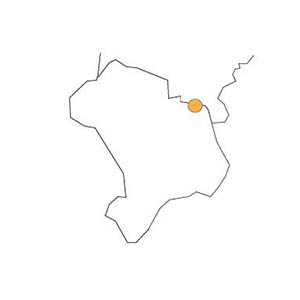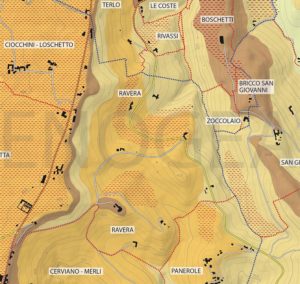Ravera
Barolo, Novello
In recent years there has been a lot of talk about the Barolo wines of Ravera and their almost exponential rise in quality, often related to climate change, which would seem to favor the traditionally cooler and later ripening zones like this.
How much truth there is in all this is difficult to say, because I believe that winemaking skills have also played a key role, but in any case these factors become secondary in light of cosiderations about the strategic position of this MGA in the landscape of the Barolo denomination.
As can be seen from the first three images, the heart of Ravera, represented by the Cascina Nuova hill and Bricco Pernice, is a real and visual watershed: what lies to the south of the two hills isn’t visible from what lies to the north and vice versa. In other words, Bricco Pernice and Cascina Nuova close the Barolo valley to the south, thus helping to create that particular microclimate we talked about in the Landscape and Microclimate section.
It follows that the best exposed vineyards of Bricco Pernice and especially of Cascina Nuova, all clearly visible in the first image, are also the most exposed to cool currents coming from the Alta Langa and the mountains (though less so than the vineyards of Merli).
As for the altitude, often cited as a determining factor of the Ravera microclimate, the extract from the geo-viticultural map shows that the highest point of Cascina Nuova is just over 400 meters, exactly the same as the highest points of Cerequio and Brunate. No further comment needed.
Turning now to the last three images, we can see that in addition to Bricco Pernice and Cascina Nuova there is a third sub-zone that refers to Cascina Pratorotondo, which is the most sheltered of all because it is shielded by the ridge of Cascina Merli. At the highest part of Cascina Nuova, lies Vigna Elena, whose particularity is linked more to the fact that the Nebbiolo Rosé clone is planted there than to the effects of altitude or exposure.
Having made these clarifications, the Barolo wines of this part of Ravera certainly reflect a cooler position than others, but at the same they show more concrete, gratifying and profound fruit than, for example, Bricco delle Viole.
Finally, to complete the overview of this MGA , we can’t neglect the many vineyards located between Cascina Ravera, Cascina Parusso and the border between Barolo and Novello. The most renowned among them occupy the highest part of the slope facing east, which in turn can be seen as the continuation of the MGA Terlo both in terms of the succession of geological formations and the style of the wines, which generally show less nuance and rhythm than those of Bricco Pernice, Cascina Nuova and Cascina Pratorotondo.
As for the geology, there is a clear prevalence of laminated Sant’Agata Fossili Marls, except in the higher areas where there are also sandy Sant’Agata Fossili Marls and Diano Sandstones, the latter in correspondence with the woods at the top of the ridge and all around Cascina Nuova.
Recommended tastings
Barolo Ravera e Barolo Bricco Pernice – Elvio Cogno; Barolo Ravera – G.D. Vajra; Barolo Ravera – Vietti
Reference tastings
Barolo Bricco delle Viole and Barolo Coste di Rose – Vajra; Barolo Rocche do Castiglione – Vietti




